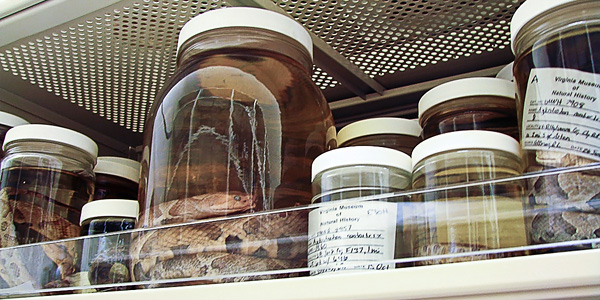Indiana Jones: “Snakes. Why’d it have to be snakes?”
Sallah: “Asps… very dangerous. You go first.”
Remember that classic exchange from Indiana Jones and the Raiders of the Lost Ark? Yet despite all of the snakes stored at the Virginia Museum of Natural History (they have more than 10,300 cataloged specimens of amphibians and reptiles), you can bet that an Archeologist like Indy would love to explore all of the collections there. We recently had an opportunity to do just that.
The museum, located in Martinsville, Virginia, is home to a collection of more than 10 million items (and growing). These items collected locally and from around the globe, provide the basis for the in-house, national and international study. Research at the museum is focused on Invertebrate Paleontology, Vertebrate Paleontology, Recent Invertebrates, Archaeology, Mammalogy, Marine Science, and Geology. Specimens in these collections are stored in special conditions to reduce damage caused by fluctuations and extremes in temperature and humidity. Most of these specimens are susceptible to deterioration caused by extended exposure to light.
For these reasons (along with space conservation and item accessibility factors), a number of special considerations were taken in the design of the storage systems required for these collections. Spread out over several rooms within the museum, Spacesaver powered high-density mobile storage systems allow the museum to continue adding to their collections without expanding their storage areas. These powered mobile systems include synchronized drive systems designed for smooth acceleration and deceleration of the carriages to minimize vibration and jarring. On several of these systems, special toe kicks were installed on the bottom of the end panels to enable curators to open aisles in the system – even if their hands are full. Museum Cabinets are prevalent on many of the mobile storage systems. These museum-grade cabinets help protect against light and other environmental hazards and can be configured to store items of all shapes and sizes. Wide span shelving is used in several areas to store over-sized items such as geological samples, fossils and mammal specimens.
Other unique design features include storage shelving that has perforated shelves that facilitate air flow and the flow of fire suppressant agents in the event of a jar breakage. Some of the shelving has clear plastic shelf fronts to protect jars and small specimen vials. There are also smooth-gliding roll-out trays and drawers for organizing and protecting small finds. Powered high-density mobile shelving can also be found in the museum’s library which houses over 7,000 titles in a collection which includes books, journals, and magazines.
Indiana Jones: “Take this. Wave it at anything that slithers.”
In the end, we didn’t need torches to wave around at any snakes during our expedition, but we did get to see a lot of neat stuff while we were there. You can see photos from our tour to the left. If you would like to learn more about the Virginia Museum of Natural History visit their website. For more information on our museum storage solutions click here.











